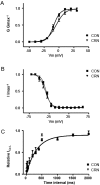The negative inotropic action of canrenone is mediated by L-type calcium current blockade and reduced intracellular calcium transients
- PMID: 19663883
- PMCID: PMC2757698
- DOI: 10.1111/j.1476-5381.2009.00329.x
The negative inotropic action of canrenone is mediated by L-type calcium current blockade and reduced intracellular calcium transients
Abstract
Background and purpose: Adding spironolactone to standard therapy in heart failure reduces morbidity and mortality, but the underlying mechanisms are not fully understood. We analysed the effect of canrenone, the major active metabolite of spironolactone, on myocardial contractility and intracellular calcium homeostasis.
Experimental approach: Left ventricular papillary muscles and cardiomyocytes were isolated from male Wistar rats. Contractility of papillary muscles was assessed with force transducers, Ca(2+) transients by fluorescence and Ca(2+) fluxes by electrophysiological techniques.
Key results: Canrenone (300-600 micromol L(-1)) reduced developed tension, maximum rate of tension increase and maximum rate of tension decay of papillary muscles. In cardiomyocytes, canrenone (50 micromol L(-1)) reduced cell shortening and L-type Ca(2+) channel current, whereas steady-state activation and inactivation, and reactivation curves were unchanged. Canrenone also decreased the Ca(2+) content of the sarcoplasmic reticulum, intracellular Ca(2+) transient amplitude and intracellular diastolic Ca(2+) concentration. However, the time course of [Ca(2+)](i) decline during transients evoked by caffeine was not affected by canrenone.
Conclusion and implications: Canrenone reduced L-type Ca(2+) channel current, amplitude of intracellular Ca(2+) transients and Ca(2+) content of sarcoplasmic reticulum in cardiomyocytes. These changes are likely to underlie the negative inotropic effect of canrenone.
Figures



Similar articles
-
Alloxan reduces amplitude of ventricular myocyte shortening and intracellular Ca2+ without altering L-type Ca2+ current, sarcoplasmic reticulum Ca2+ content or myofilament sensitivity to Ca2+ in Wistar rats.Mol Cell Biochem. 2010 Jul;340(1-2):115-23. doi: 10.1007/s11010-010-0408-7. Epub 2010 Feb 20. Mol Cell Biochem. 2010. PMID: 20174963
-
The Na+/Ca2+ exchange blocker SEA0400 fails to enhance cytosolic Ca2+ transient and contractility in canine ventricular cardiomyocytes.Cardiovasc Res. 2008 Jun 1;78(3):476-84. doi: 10.1093/cvr/cvn031. Epub 2008 Feb 5. Cardiovasc Res. 2008. PMID: 18252759
-
Hydrogen sulphide is an inhibitor of L-type calcium channels and mechanical contraction in rat cardiomyocytes.Cardiovasc Res. 2008 Sep 1;79(4):632-41. doi: 10.1093/cvr/cvn140. Epub 2008 Jun 4. Cardiovasc Res. 2008. PMID: 18524810
-
Calcium-induced calcium release from the sarcoplasmic reticulum can be evaluated with a half-logistic function model in aequorin-injected cardiac muscles.J Anesth. 2011 Dec;25(6):831-8. doi: 10.1007/s00540-011-1234-0. Epub 2011 Oct 8. J Anesth. 2011. PMID: 21979103
-
Serotonin increases L-type Ca2+ current and SR Ca2+ content through 5-HT4 receptors in failing rat ventricular cardiomyocytes.Am J Physiol Heart Circ Physiol. 2007 Oct;293(4):H2367-76. doi: 10.1152/ajpheart.01375.2006. Epub 2007 Jul 27. Am J Physiol Heart Circ Physiol. 2007. PMID: 17660386
Cited by
-
Endogenous cardiotonic steroids in kidney failure: a review and an hypothesis.Adv Chronic Kidney Dis. 2015 May;22(3):232-44. doi: 10.1053/j.ackd.2014.12.005. Adv Chronic Kidney Dis. 2015. PMID: 25908473 Free PMC article. Review.
-
Spironolactone as a Potential New Treatment to Prevent Arrhythmias in Arrhythmogenic Cardiomyopathy Cell Model.J Pers Med. 2023 Feb 15;13(2):335. doi: 10.3390/jpm13020335. J Pers Med. 2023. PMID: 36836569 Free PMC article.
References
-
- Barbato JC, Mulrow PJ, Shapiro JI, Franco-Saenz R. Rapid effects of aldosterone and spironolactone in the isolated working rat heart. Hypertension. 2002;40:130–135. - PubMed
-
- Baskin SI, Akera T, Puckett CR, Brody SL, Brody TM. Effect of potassium canrenoate on cardiac functions and (Na ++ K +)-activated ATPase. Proc Soc Exp Biol Med. 1973;143:495–498. - PubMed
-
- Bassani JWM, Yuan W, Bers DM. Fractional SR Ca release is regulated by trigger Ca and SR Ca content in cardiac myocytes. Am J Physiol. 1995b;268:C1313–C1319. - PubMed
Publication types
MeSH terms
Substances
LinkOut - more resources
Full Text Sources
Miscellaneous

